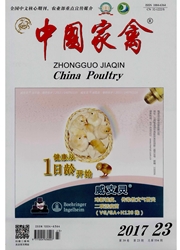

 中文摘要:
中文摘要:
为探讨获得大量高纯度乌骨鸡黑色素细胞不同方法的优劣,以及进一步研究马骨鸡黑色素细胞生物特性及其黑色素的生物合成,以1周龄乌骨鸡雏鸡腹侧皮肤作为黑色素细胞来源,采用胰蛋白酶、中性蛋白酶和胶原酶Ⅰ消化进行细胞产量和贴壁效率评估,杂细胞用十四烷酰佛波醇乙酸酯(TPA)选择性消除,最后细胞长期培养在添加胎牛血清、碱性成纤维细胞生长因子、TPA和实验室自制活性肽的DMEM基础培养基中.利用多巴染色法、透射电镜对获得细胞的性质进行鉴定.结果显示,胶原酶Ⅰ较中性蛋白酶和胰蛋白酶消化分离获得的黑色素细胞具有更高细胞产量和细胞活力,原代培养5d后,达到融合,未见角质形成细胞和成纤维细胞污染.因此,采用胶原酶Ⅰ消化并使用添加多种刺激因子的培养基,可建立乌骨鸡黑色素细胞的有限细胞系.
 英文摘要:
英文摘要:
To explore the different methods for isolation of pure melanocytes from black-bone silky fowl(BSF), and study further with biological behavior and melanogenesis of BSF melanocytes, skins were harvested from the ventral region of one-week-age BSF and digested by trypsin,dispase and eollagenase I to evaluate the yield of viable cells and attachment in vitro. Contaminant cells were eliminated by a selective cytotoxic agent, tetradecanoyl phorbol acetate (TPA). Finally, the cells were cultured with DMEM medium supplemented by fetal bovine serum, basic fibroblast growth factor,TPA and WJ manufactured by our laboratory. The L-Dopa staining and transmission electron microscopy were used to identify the properties of obtained cells. The cell yields and cell attached in collagenase I group was significantly greater than that in dispase and trypsin groups. Cells become confluent after primarily cultured for 5 days in melanocyte culture medium,and contaminant cells such as keratinocyte and fibroblast weren't appeared. Collagenase I digestion and medium supplemented with stimulating factor were contributed to establish BSF melanocyte line.
 同期刊论文项目
同期刊论文项目
 同项目期刊论文
同项目期刊论文
 期刊信息
期刊信息
